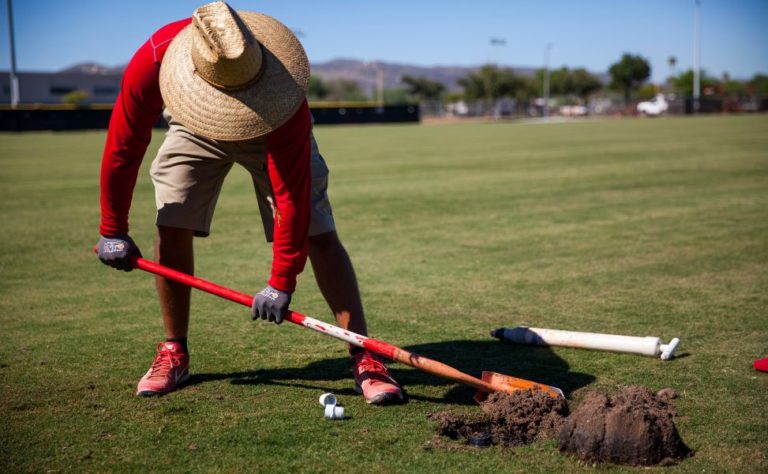By Chris Ball, CSFM
A little about me: I’m 45, a sports field account manager based out of Ewing Garner near Raleigh, N.C., working with customers throughout the Carolinas and the Southeastern United States. Before joining Ewing, I worked for 20 years as a Minor League Baseball sports field manager primarily in Myrtle Beach, S.C., and Gwinnett County, Ga.
I spent most of my childhood outdoors, playing ball, going to the beach, golfing and boating. As a very fair-skinned redhead, I was the kid slathered in thick, white sunscreen by my mother every day in the summer. I fought her on sunscreen every single time I went outside in those days, but I am so thankful she made it an important part of my routine. These days, I apply sunscreen every day before I head out into the world. I keep it in my truck, in my golf bag, garage, boat, and in wife’s vehicle so I can reapply throughout the day.
Why am I sharing this? Sun safety is very personal to me, and if my journey with sun-related skin damage convinces others who work and play outdoors to take it seriously, I’m happy to share.
Ongoing issues need frequent monitoring
I’ve been dealing with serious sun damage issues since 2009, when the skin on my face, arms, and hands dried out so badly I sought help from my physician. My face would get so dry that I couldn’t shave. My physician referred me to a dermatologist, and I requested he conduct a comprehensive skin check during my first appointment. The dermatologist had a field day with me. By the time my hour-and-a-half appointment wrapped up, he had frozen off 11 sun spots, cut out four trouble spots to biopsy, and scheduled a follow-up appointment in two weeks to go over biopsy results and freeze off more sun spots.
That really rattled my cage. I lost a sister to cancer in 2007, so the word “biopsy” scares the hell out of me. All four areas biopsied were found to be precancerous, so I didn’t need to have more work done on them at that time, but it would come later.
As a result of my first two visits to the dermatologist, I knew I had to take better care of my skin and be more conscious of my time in the sun. I bought high-quality sunscreen, and started wearing long-sleeved SPF-rated shirts, wide-brimmed bucket hats, and quality sunglasses – even on days that weren’t bright and sunny, because the sun still affects your skin just as harshly.
I also took my dermatologist’s advice to schedule regular screenings every four months, which I continue to this day.
My regular post-baseball season screening in September 2014 resulted in an unexpected surgery the following week when the dermatologist discovered that an area almost in the middle of my spine had grown rapidly over the four months since my last screening. Though it required removal and another biopsy, I thought no big deal – we’ll get it out and move on. I didn’t understand that even if it’s not cancer, the dermatologist will continue to remove irregular areas to try to get all of the precancerous growth. It took three different procedures and plastic surgery to resolve the issue on my spine. The scar resembles a bullet hole.
In 2018, an irregular patch on my arm was removed. The spot was the size of a grain of rice, but that little gem turned out 13 stitches. In total, I’ve had eight precancerous areas removed, and I’m sure there will be more.
It’s not fun to get cut on and stitched up, then visit a plastic surgeon. I wish I would have paid better attention to my skin the last 25 to 30 years, because it’s miserable to get something cut off or out, frozen off, or tested each time I visit my dermatologist. That said, I’m grateful to be one of the lucky ones. Thanks to regular screenings and procedures, none of my precancerous areas have progressed to cancer.
That’s why it’s so important to me to share my story with my colleagues in the green industry and to advocate to those who work outdoors that it’s imperative to take better care of your skin and to schedule a skin exam. That appointment could be the most important half-hour of your life.
Below are some facts about skin cancer and sun safety tips for you and your crews.
Some facts about skin cancer
According to the Centers for Disease Control and Prevention, skin cancer is the most common form of cancer in the United States. The three most common types are basal and squamous cell carcinomas, and melanoma. To learn more about each, visit the skin cancer page on the CDC’s website (https://www.cdc.gov/cancer/skin/index.htm).
Most cases of skin cancer are caused by overexposure to ultraviolet (UV) rays from the sun, tanning beds, or sunlamps. There are two types of UV rays—UVA (associated with aging) and UVB (associated with sunburn). To learn more about each, visit the UV radiation page on the Skin Cancer Foundation’s website (https://www.skincancer.org/risk-factors/uv-radiation/). People who work outdoors are especially at risk of overexposure, regardless of their other risk factors.
Many of us tend to think about sun safety when it’s hot and sunny, but that’s a mistake that can cost your skin. Per the CDC, UV rays are present on cool, cloudy days, and they can reflect off surfaces such as water, cement, sand, and snow so sun safety should be practiced daily regardless of weather.
In the continental United States, UV rays are strongest between 9 a.m. and 3 p.m. standard time and between 10 a.m. and 4 p.m. daylight saving time. When the UV index is 3 or higher, the CDC advises protecting your skin from too much exposure to the sun. To determine the UV index in your local area, visit the U.S. Environmental Protection Agency’s UV Index Search page (https://www.epa.gov/enviro/uv-index-search). Enter your ZIP code or city and state to calculate the intensity of UV rays where you are with one click.
Sun safety tips
According to the CDC, reducing exposure to UV rays is the best way to keep your skin healthy and to lower your chance of developing skin cancer. That can be difficult for crews who work outdoors, but it can, and should, be done. Here are some ways managers can help keep their crews safe:
- Encourage sun safety among employees and provide sun protection when possible.
- If shaded areas aren’t available at jobsites, provide tents, shelters, and cooling stations for your crews.
- Schedule breaks in the shade and encourage crewmembers to apply sunscreen throughout their shifts.
- Schedule work to minimize sun exposure if possible. For example, scheduling mowing in the early morning instead of at midday and rotating crewmembers in and out of the shade can help reduce their UV exposure.
More tips that everyone working outdoors should consider:
- Wear clothing that covers your arms and legs.
- Wear a wide-brimmed hat to shade your face, head, ears, and neck.
- Wear wrap-around sunglasses designed to block both UVA and UVB rays.
- Use a broad-spectrum sunscreen with a sun protection factor (SPF) of 15 or higher, and apply it several times during the day.
For information on early detection, treatment, and resources, visit https://www.skincancer.org/.
If you have any questions about my personal experience with sun damage or want to share your own experience with me, email me at cball@ewingirrigation.com.
Chris Ball, CSFM, is sports field account manager at Ewing Irrigation & Landscape Supply.
This article appears in the May issue of SportsField Management magazine, available now.



